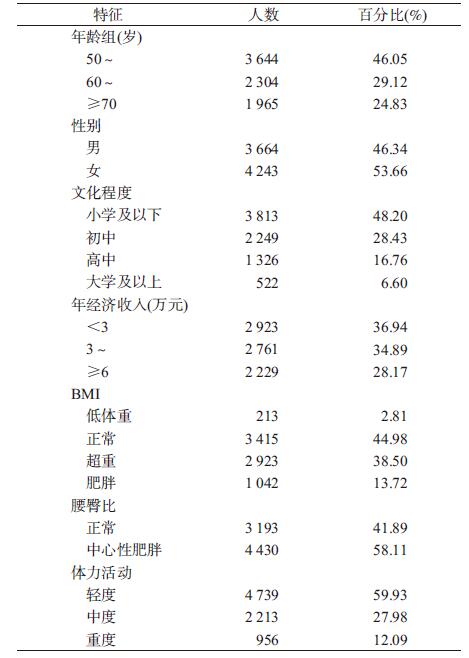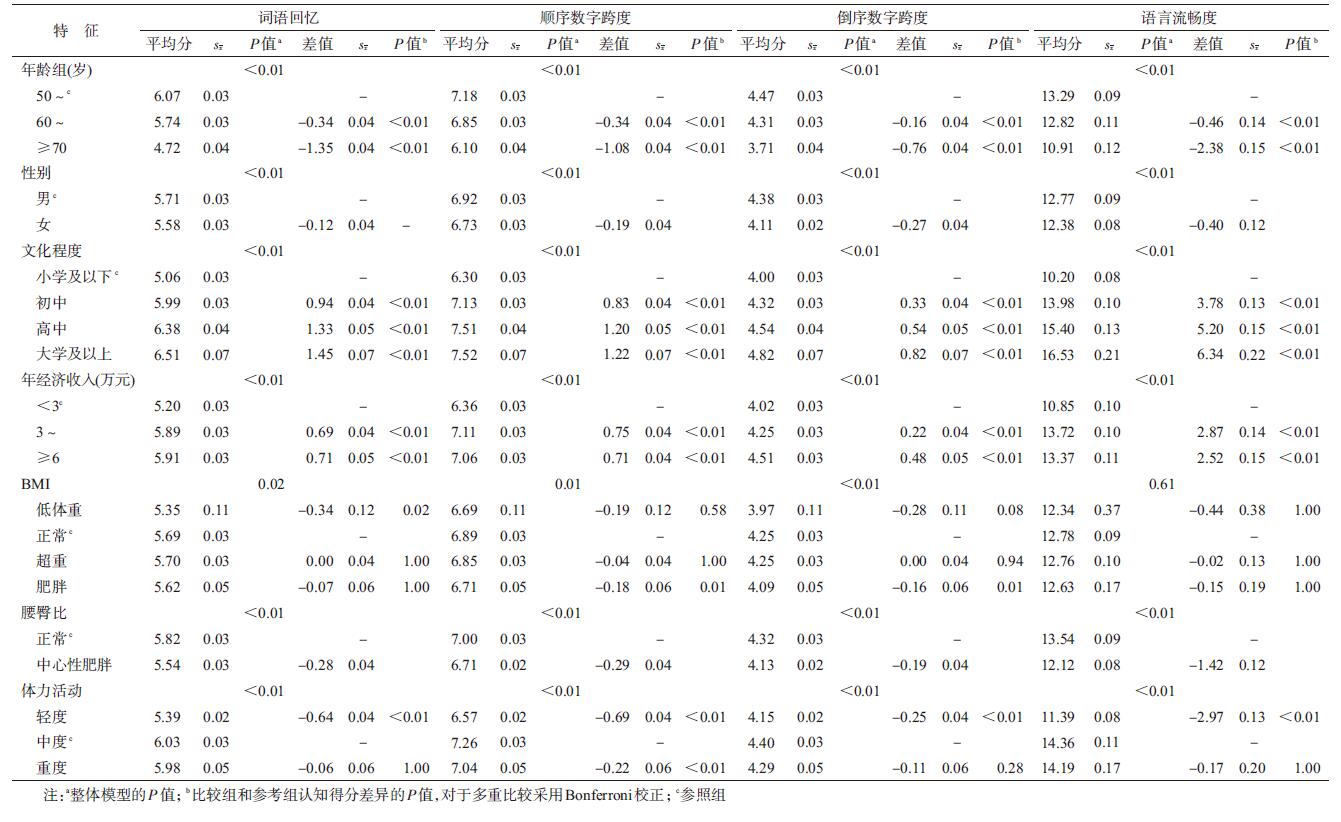文章信息
- 黄哲宙, 张玉成, 郑杨, 郭雁飞, 阮晔, 孙双圆, 施燕, 高淑娜, 叶景虹, 严玉洁, 吴抗, 徐瑞芳, 吴凡.
- Huang Zhezhou, Zhang Yucheng, Zheng Yang, Guo Yanfei, Ruan Ye, Sun Shuangyuan, Shi Yan, Gao Shuna, Ye Jinghong, Yan Yujie, Wu Kang, Xu Ruifang, Wu Fan.
- 上海市50岁及以上老年人群肥胖和体力活动与认知功能的关系
- Associations of obesity and physical activity with cognition in people aged 50 and above in Shanghai
- 中华流行病学杂志, 2018, 39(3): 273-279
- Chinese Journal of Epidemiology, 2018, 39(3): 273-279
- http://dx.doi.org/10.3760/cma.j.issn.0254-6450.2018.03.005
-
文章历史
收稿日期: 2017-10-12
2. 200011 上海市黄浦区疾病预防控制中心;
3. 200437 上海市虹口区疾病预防控制中心;
4. 201100 上海市闵行区疾病预防控制中心;
5. 200136 上海市浦东新区疾病预防控制中心;
6. 201700 上海市青浦区疾病预防控制中心
2. Huangpu District Center for Disease Control and Prevention, Shanghai 200011, China;
3. Hongkou District Center for Disease Control and Prevention, Shanghai 200437, China;
4. Minhang District Center for Disease Control and Prevention, Shanghai 201100, China;
5. Pudong District Center for Disease Control and Prevention, Shanghai 200136, China;
6. Qingpu District Center for Disease Control and Prevention, Shanghai 201700, China
我国是世界上人口老龄化较为严重的地区之一。2016年底,全国≥60岁老年人口2.31亿,预计2025年将突破3亿,2033年将突破4亿,2053年将达到峰值4.87亿,占届时全球老年人口的1/4[1]。人体正常老化在晚年会导致大脑结构性萎缩和不同程度的认知功能下降[2]。认知功能障碍是老年人最常见的疾病之一。认知功能障碍早期表现为轻度认知功能障碍,随后慢慢发展为痴呆、阿尔茨海默症等疾病[3]。据估计,我国≥65岁老年人轻度认知功能障碍的患病率为20.8%[4],痴呆的患病率为5.14%[5]。研究能延缓或改善老年人认知功能下降的因素,从而采取针对性的预防、干预措施,将具有重要的公共卫生学意义。目前已知的影响老年人认知功能的最主要因素是年龄和教育水平[6],还鲜有关于其他可改变的影响因素的研究。国外一些在痴呆患者中开展的研究显示,体重控制和体力活动能延缓痴呆患者的认知功能下降速度[7]。本研究旨在探索正常老年人肥胖和体力活动与认知功能的关联。
对象与方法1.研究对象:来源于WHO“全球老龄化与成人健康前瞻性研究”(Study on global AGEing and adult health,SAGE)第一轮调查上海现场数据。共调查≥50岁研究对象8 514名,其中8 307人完成认知能力测试,排除既往脑卒中374名,既往脑卒中状态未知20名,最终纳入研究对象7 913名。
2.研究方法:
(1)抽样方法和调查内容:该调查以区为基本抽样单位,通过多阶段随机整群抽样方法抽取研究对象[8]。从2009年10月至2010年6月,由接受过系统培训的上海市各区CDC及社区卫生服务中心/乡村医疗室的医务人员,采用WHO SAGE项目指定的统一调查工具,对研究对象进行问卷调查。收集研究对象的社会人口学特征、健康状态等情况,并对研究对象进行体格测量(身高、体重、腰围、臀围等)及认知能力测试。最终,调查共联系≥50岁家庭户5 600户,应答户数5 134户,应答率为91.7%;联系≥50岁调查对象8 872名,应答8 638名,应答率为97.4%。
(2)认知能力测试:①词语回忆:评估受试者学习能力、记忆量和记忆力。连续告诉调查对象10个单词,让其尽可能多地复述,重复3次以加强记忆。10 min后,4次测试得分的平均分。②顺序数字跨度:测试受试者注意力和即时记忆力。要求受试者复述一组数字,数字长度由短到长,正确说出一组数字,则按照正确复述的数字长度计分,最高9分。③倒序数字跨度:除要求受试者倒叙复述数字外,其他同顺序数字跨度测试。最高得分8分。④语言流畅度:评估受试者重新获得语义记忆信息的能力。要求受试者在1 min内尽可能说出所知道的词语(动物),正确说出一种动物名称得1分。
(3)相关指标定义:①根据国家卫生和计划生育委员会《成人体重判定》[9],BMI分组:<18.5 kg/m2为低体重;18.5~23.9 kg/m2为正常;24.0~27.9 kg/m2为超重;≥28.0 kg/m2为肥胖。②腰臀比:为受试者腰围(cm)与臀围(cm)之比。将男性腰臀比≥0.90、女性腰臀比≥0.85定义为“中心性肥胖”;男性腰臀比<0.90,女性腰臀比<0.85定义为“正常”[10]。③体力活动:根据WHO Global Physical Activity Questionnaire(GPAQ)analysis guide[11],将体力活动分为轻度、中度、重度3组。
3.统计学分析:应用SAS 9.4软件进行统计学分析。采用中位数和四分位数间距对认知功能得分进行描述。分别以4项认知功能得分为因变量,通过一般线性模型对与认知功能相关的因素进行单因素和多因素分析。所有统计检验均为双侧检验,检验水准α=0.05。
结果1.一般特征:7 913名研究对象的年龄M=60(QR=14)岁;男性占46.34%,女性占53.66%;文化程度为小学及以下占48.20%,初中28.43%,高中16.76%,大学及以上6.60%;年经济收入M=3.60(QR=3.08)万元。按BMI分类标准,44.98%为正常体重,2.81%为低体重,38.50%为超重,13.72%为肥胖;按腰臀比分类标准,58.11%为中心性肥胖。59.93%的研究对象体力活动水平为轻度,27.98%为中度,12.09%为重度。见表 1。
2.认知功能得分:研究对象的词语回忆得分M=5.75(QR=2.25)分,顺序数字跨度得分M=7(QR=2)分,倒序数字得分M=4(QR=2)分,语言流畅度得分M=12(QR=7)分。见表 2。
3.单因素分析:年龄、性别、文化程度、年经济收入与4项认知功能得分均有显著关联(均P<0.01)。年龄越大,认知得分越低。与50~59岁组相比,60~69岁和≥70岁老年人4项认知功能得分都更低(均P<0.01)。女性4项认知功能得分均低于男性(均P<0.01)。文化程度越高,认知功能得分越高。与小学及以下文化程度的人相比,其他文化程度的人4项认知功能得分都更高(均P<0.01)。与年经济收入<3万元的人相比,收入在3~万和≥6万以上的人4项认知功能得分都更高(均P<0.01)。BMI与词语回忆(P=0.02)、顺序数字跨度(P=0.01)和倒序数字跨度(P<0.01)得分均有显著关联,与语言流畅度没有显著关联(P=0.61)。与体重正常者相比,低体重者的词语回忆得分低0.34分(P=0.02),而肥胖者的顺序数字跨度低0.18分(P=0.01)和倒序数字跨度低0.16分(P=0.01)。腰臀比和体力活动水平与4项认知功能得分均有显著关联(均P<0.01)。中心性肥胖者的4项认知功能得分均低于腰臀比正常者(P<0.01)。与中度体力活动者相比,轻度体力活动者的4项认知功能得分都更低(均P<0.01),而重度体力活动者只有顺序数字跨度低0.22分(P<0.01)。见表 3。
4.多因素分析:将年龄、性别、文化程度和年经济收入纳入模型,进行多因素分析,结果显示,BMI与4项认知功能得分的关联都不显著(均P>0.01)。腰臀比只与语言流畅度有显著关联(P<0.01),中心性肥胖者的语言流畅度得分低于腰臀比正常者0.61分(P<0.01)。体力活动水平与4项认知功能得分仍有显著关联(均P<0.01),与单因素分析结果一致。与中度体力活动者相比,轻度体力活动者的4项认知功能得分都更低(均P<0.01),而重度体力活动者只有顺序数字跨度低0.21分(P<0.01)。见表 4。
将年龄、性别、文化程度和年经济收入纳入模型,并且同时将BMI、腰臀比和体力活动水平一起纳入模型进行多因素分析,结果与表 4一致。腰臀比只与语言流畅度有显著关联(P<0.01),体力活动水平与4项认知功能得分均有显著关联(均P<0.05)。见表 5。
本研究还采用了交叉因素模型,分析了BMI、腰臀比和体力活动水平3个变量对4项认知功能得分是否存在一级和二级交互作用,在模型中纳入BMI×腰臀比、BMI×体力活动水平、腰臀比×体力活动水平、BMI×腰臀比×体力活动水平4个交互作用项。结果显示,4个交互作用项都没有显著性意义(均P>0.05)。见表 6。
本研究利用了WHO“全球老龄化与成人健康前瞻性研究”第一轮调查上海现场数据,分析了≥50岁老年人群肥胖和体力活动与认知功能的关系。研究发现,中心性肥胖和体力活动不足的老年人认知功能得分更低。
尽管老龄化导致的大脑萎缩和认知功能下降的关联还并不明确,大脑的结构影像学近年来为这一关联的探索提供了宝贵的证据[12]。例如,执行功能(包括注意力、处理速度和抑制控制等)很大程度上受额叶皮质的控制。额叶皮质的体积和功能的萎缩有3个不同时期,20~40岁开始萎缩并逐渐加速萎缩,40~60岁萎缩速度放慢,≥60岁又开始加速萎缩[12]。记忆功能则很大程度上受海马体的控制。海马体在60岁之前萎缩的速度都较为稳定,60岁及以后萎缩速度随着年龄的上升而明显加速[12-13]。一些研究显示,健康老年人中肥胖与认知障碍有关联,可能的生理机制包括肥胖相关的先天免疫激活和大脑结构改变。高BMI与缩短的神经束纤维长度和缩小的大脑体积显著相关,导致认知下降[14-15]。近期一些研究还显示,中心性肥胖是认知下降的独立的危险因素[16]。据国外一项研究中心肥胖和大脑结构磁共振影像的横断面研究报道,高腰臀比与更小的海马体体积和更多的白质高信号有显著关联[17]。本研究发现,中心性肥胖者的语言流畅度得分显著低于腰臀比正常者,提示腰围控制可能有助于老年人维持其认知功能。
此外,大量研究还显示,体力活动对痴呆患者认知功能的下降有保护作用[18]。可能是通过升高神经营养因子水平、促进血管和突触的形成、减少炎症、减少异常蛋白的沉积等生理机制,对大脑结构起到神经保护和神经重塑的作用。既往研究多显示,体力活动较多的研究对象认知功能得分更高[19]。有随机对照试验发现,通过有氧训练可以增加海马体的体积,从而提高认知水平[20]。本研究结果与既往研究结果一致。与中度体力活动相比,体力活动不足者的4项认知功能得分均更低,提示适当的体力活动有助于老年人维持其认知功能。
本研究采用WHO SAGE第一轮调查上海现场数据,样本量大、应答率高,研究设计合理,研究结果可信度高。但本研究为该人群队列的基线调查,为横断面调查,因此在因果推断时受限,后续如结合该人群队列的随访数据,可对本次基线调查的研究结果进行进一步验证。
综上所述,本研究结果显示,中心性肥胖和体力活动不足的老年人认知功能得分更低,提示腰围控制和适当的体力活动有助于老年人维持其认知功能。
利益冲突: 无
| [1] |
邹波. 中国老龄化的现状与积极应对[J]. 中国民政, 2017(20): 42–44.
Zou B. The current situation and positive coping of ageing in China[J]. China Civil Affairs, 2017(20): 42–44. |
| [2] | Bishop NA, Lu T, Yankner BA. Neural mechanisms of ageing and cognitive decline[J]. Nature, 2010, 464(7288): 529–535. DOI:10.1038/nature08983 |
| [3] | Mitchell AJ, Shiri-Feshki M. Rate of progression of mild cognitive impairment to dementia-Meta-analysis of 41 robust inception cohort studies[J]. Acta Psychiatr Scand, 2009, 119(4): 252–265. DOI:10.1111/j.1600-0447.2008.01326.x |
| [4] | Jia JP, Zhou AH, Wei CB, et al. The prevalence of mild cognitive impairment and its etiological subtypes in elderly Chinese[J]. Alzheimer's Dement, 2014, 10(4): 439–447. DOI:10.1016/j.jalz.2013.09.008 |
| [5] | Jia JP, Wang F, Wei CB, et al. The prevalence of dementia in urban and rural areas of China[J]. Alzheimer's Dement, 2014, 10(1): 1–9. DOI:10.1016/j.jalz.2013.01.012 |
| [6] | Rexroth DF, Tennstedt SL, Jones RN, et al. Relationship of demographic and health factors to cognition in older adults in the ACTIVE study[J]. J Aging Health, 2013, 25(8 Suppl): S128–146. DOI:10.1177/0898264313498415 |
| [7] | Kane RL, Butler M, Fink HA, et al.Interventions to prevent age-related cognitive decline, mild cognitive impairment, and clinical Alzheimer's-type dementia[M]. Rockville (MD): Agency for Healthcare Research and Quality (US), 2017. |
| [8] |
上海市疾病预防控制中心. 全球老龄化与成人健康中国研究报告(第一轮)[M]. 上海: 上海科学技术出版社, 2014.
Shanghai municipal center for disease control and prevention.Study on global AGEing and adult health (SAGE), Wave 1[M]. Shanghai: Shanghai scientific & technical publishers, 2014. |
| [9] |
中华人民共和国国家卫生和计划生育委员会. WS/T 428-2013成人体重判定[S]. 北京: 中国质检出版社, 中国标准出版社, 2013.
National health and family planning commission of the people's republic of China. WS/T 428-2013 Criteria of weight for adults[S]. Beijing: China zhijian publishing house, Standards Press of China, 2013. |
| [10] | World Health Organization. Waist circumference and waist-hip ratio[Z]. Geneva: WHO, 2011. |
| [11] | World Health Organization. Global Physical Activity Questionnaire (GPAQ) analysis guide[Z]. Geneva: WHO. |
| [12] | Lockhart SN, DeCarli C. Structural imaging measures of brain aging[J]. Neuropsychol Rev, 2014, 24(3): 271–289. DOI:10.1007/s11065-014-9268-3 |
| [13] | Dickerson BC, Salat DH, Bates JF, et al. Medial temporal lobe function and structure in mild cognitive impairment[J]. Ann Neurol, 2004, 56(1): 27–35. DOI:10.1002/ana.20163 |
| [14] | Bolzenius JD, Laidlaw DH, Cabeen RP, et al. Brain structure and cognitive correlates of body mass index in healthy older adults[J]. Behav Brain Res, 2015, 278: 342–347. DOI:10.1016/j.bbr.2014.10.010 |
| [15] | Bolzenius JD, Laidlaw DH, Cabeen RP, et al. Impact of body mass index on neuronal fiber bundle lengths among healthy older adults[J]. Brain Imaging Behav, 2013, 7(3): 300–306. DOI:10.1007/s11682-013-9230-7 |
| [16] | Kerwin DR, Gaussoin SA, Chlebowski RT, et al. Interaction between body mass index and central adiposity and risk of incident cognitive impairment and dementia:results from the Women's Health Initiative Memory Study[J]. J Am Geriatr Soc, 2011, 59(1): 107–112. DOI:10.1111/j.1532-5415.2010.03219.x |
| [17] | Jagust W, Harvey D, Mungas D, et al. Central obesity and the aging brain[J]. Arch Neurol, 2005, 62(10): 1545–1548. DOI:10.1001/archneur.62.10.1545 |
| [18] | Radak Z, Hart N, Sarga L, et al. Exercise plays a preventive role against Alzheimer's disease[J]. J Alzheimers Dis, 2010, 20(3): 777–783. DOI:10.3233/JAD-2010-091531 |
| [19] | Kirk-Sanchez NJ, Mcgough EL. Physical exercise and cognitive performance in the elderly:current perspectives[J]. Clin Interv Aging, 2014, 9: 51–62. DOI:10.2147/CIA.S39506 |
| [20] | Erickson KI, Voss MW, Prakash RS, et al. Exercise training increases size of hippocampus and improves memory[J]. Proc Natl Acad Sci USA, 2011, 108(7): 3017–3022. DOI:10.1073/pnas.1015950108 |
 2018, Vol. 39
2018, Vol. 39








